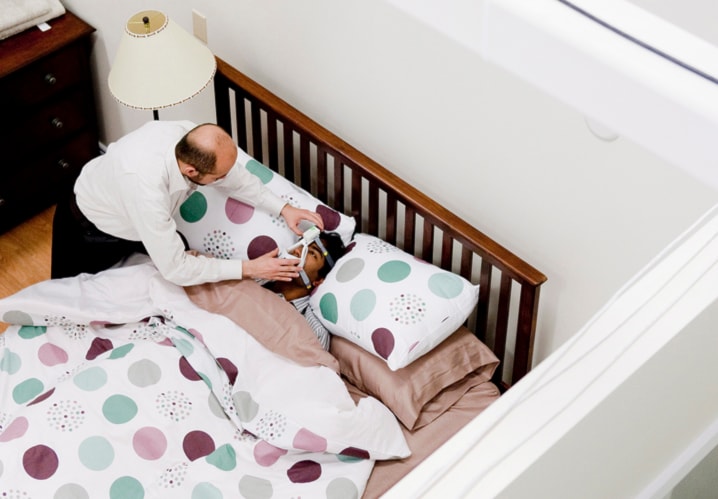TORONTO — When Kathy Donkner was diagnosed with sleep apnea, she spent several nights in a sleep lab, hooked to scores of electrodes tying her to a device that gathered data about her breathing and sleep patterns.
The procedure didn’t make for the most comfortable of nights, she acknowledges. Getting up to go to the bathroom, for instance, was an ordeal that involved calling for help to unplug herself from the monitor collecting her sleep data.
“You can’t just get up and go, right? You feel like a little kid asking for permission to go to the bathroom,” she says with a chuckle.
So Donkner can appreciate the appeal of being tested for sleep apnea in her own home, with a device that wouldn’t require electrodes and belts and cameras monitoring her every nocturnal toss and turn.
“I think a lot more people would actually go and be tested for it, if they didn’t have to go through the nonsense that you have to do when you have to go to the sleep clinic,” says Donkner, 48, an early childhood educator from the Toronto area.
Scientists at Toronto Rehab, a treatment and research hospital, are working on just such a diagnostic system for sleep apnea, a condition where breathing is disrupted during sleep.
The system, still in the development stages, centres on a recording device worn over the face during sleep. A built-in microphone picks up airway sounds from the sleeper and the device records the data on a flash memory card that can capture eight hours worth of information.
The way the system is designed to work is that the memory card — or the information on it — would then be submitted for analysis. A computer program the team has written looks for patterns that indicate the existence of sleep apnea.
Sleep apnea is a condition where a person’s airway collapses temporarily during sleep, triggering pauses in breathing that can vary in length from a few seconds to minutes.
The sleeper generally resumes breathing with a snort or a start that restores consciousness, albeit briefly. These sleep disruptions, which can occur many times per hour, undermine the person’s quality of sleep, leaving the person sleep-deprived.
Studies have linked sleep apnea to an increased risk of heart disease. And in a cruel catch-22, inadequate amounts of sleep are thought to contribute to weight gain, which is one of the risk factors for sleep apnea.
Rates of the condition rise between the ages of 40 and 45, says Toronto sleep specialist Dr. Douglas Bradley, with between five and 10 per cent of the adult population of North America suffering from obstructive sleep apnea. People often gain weight and lead more sedentary lives as they age, increasing the likelihood they will develop the condition.
Bradley, who is involved in this project, says only 10 to 15 per cent of people with sleep apnea have been diagnosed. Some cases are only recognized when excessive daytime sleepiness — one of the main symptoms of sleep apnea — become problematic.
That was the case with Donkner, who blacked out while driving her car. “I remembered starting to accelerate and then the next thing I knew I was in the back of another car. I had submarined under another car.”
Fortunately neither she nor the people she hit were seriously hurt, though her car was totalled. She now sleeps with a CPAP machine; the acronym stands for continuous positive airway pressure. It inflates her airway and keeps her breathing in a sustained manner — which allows her to get a full night’s sleep.
Bradley says even if all the people who have undiagnosed sleep apnea came forward for testing, Canada doesn’t have enough sleep labs to handle that patient load. That reality — along with the cost of diagnosing the condition through a visit to a sleep lab — is behind the work to develop a device that would allow people to be diagnosed at home.
The current prototype, designed by Dr. Hisham Alshaer and others at Toronto Rehab, is a stand-alone unit that does not require the sleeper to wear electrodes or be attached to a monitor.
Instead, the person would wear a plastic mask-like device while he or she sleeps. The device is held in place with fabric straps that encircle the skull.
The device is shaped like a wish bone, with a couple of ribs arching across the two arms of the Y shape, holding a small microphone in place over the nose and mouth.
Alshaer, a medical doctor who is working on a PhD in biomedical engineering, says people who test the device are asked to rate it based on how comfortable it is to wear and how easy it is to operate. So far the device has received an approval rating of around 70 per cent, he says, adding he expects fine-tuning of the prototype will improve patient reaction.
The Toronto Rehab team is currently testing the system to ensure the device and the program devised to read the data it captures can lead to an accurate diagnosis of sleep apnea.
So far the testing looks good, Bradley says. A comparison to the gold standard of tests, a polysomnogram — the in-lab test Donkner described — suggests it captures about 94 per cent of cases. Volunteers are now using the device at home so that the team can see if it works as well in the real world as it does in the laboratory.
There are still hoops to be jumped through. The team is still trying to figure out how to bring the device and the computer program needed to analyze the data to market. But Bradley says he expects that may be achieved within about a year.
